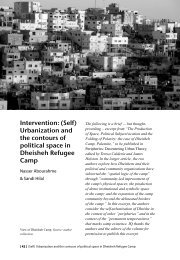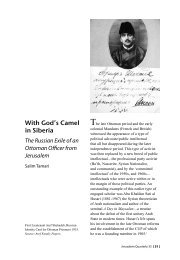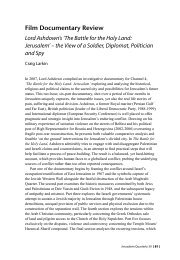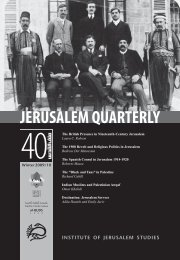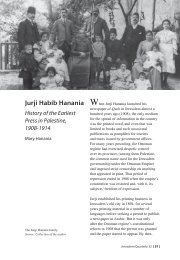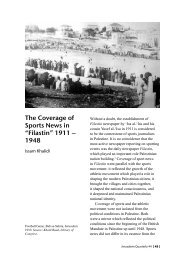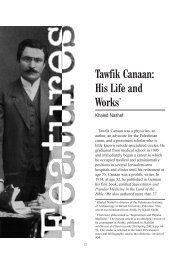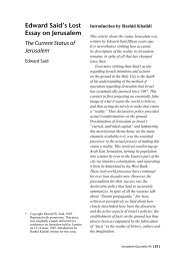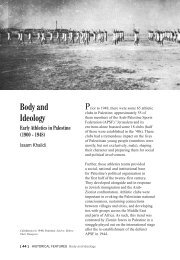PLUNDERING PALESTINE - Jerusalem Quarterly
PLUNDERING PALESTINE - Jerusalem Quarterly
PLUNDERING PALESTINE - Jerusalem Quarterly
Create successful ePaper yourself
Turn your PDF publications into a flip-book with our unique Google optimized e-Paper software.
as commodities, consumer demand and perceived threats to the material past played<br />
integral roles in the development of the laws governing legal and illegal trade.<br />
Later legislative efforts of the Ottoman Empire and the subsequent British Mandate<br />
government in the area sought to rectify the depletion of relics and the attendant<br />
mining of archaeological sites to supply the ever-increasing demand.<br />
Legal Antecedents<br />
The Ottoman Law of 1884<br />
In response to increasing foreign interest in the area and the looting of archaeological<br />
material from the Empire, 8 an early Ottoman Antiquities Law was passed in 1874 for<br />
the regulation of antiquities trafficking. This first antiquities law was primarily aimed<br />
at foreign nationals and was written as a protection mechanism. A later Ottoman law<br />
enacted in 1884 (1884 Law) established national patrimony (ownership) 9 over all<br />
artefacts in the Ottoman Empire and sought to regulate scientific access to antiquities<br />
and sites (excavation permits were required). Under the law, all artefacts discovered<br />
during excavation were the property of the National Museum in Constantinople and<br />
were to be sent there until those in charge made decisions about the disposition of the<br />
finds. This law could be considered the first instance that archaeological material from<br />
the region was deemed important enough to pass legislation to ensure its safekeeping.<br />
Alternatively the law could be construed as legalized cultural imperialism 10 –motivated<br />
by the Ottoman Empire’s desire to appropriate material from its territories rather<br />
than for the preservation of the archaeological legacy of the region. By controlling<br />
archaeological goods and taxing the antiquities sales in the periphery, the government<br />
effectively regulated European access to heritage, access that had been previously<br />
unfettered.<br />
Most of the provisions articulated in the 1884 Law seemed reasonable, but practical<br />
enforcement of this law was virtually impossible. The expanse of the empire was<br />
so great that the Ottoman government did not have enough officials to oversee and<br />
implement the various regulations of the 1884 Law and the inherent bureaucracy<br />
often delayed excavation permits for almost a year. 11 Foreign excavators who<br />
previously had unregulated access to the finds from their forays into the field were<br />
extremely dissatisfied with the new provision that all artefacts had to be vetted by<br />
the Imperial Museum in Constantinople prior to study and/or analysis. 12 In an effort<br />
to curb the loss of cultural heritage from the empire, Chapter I Article 8 of the 1884<br />
Law specifically prohibited the exporting of artefacts without the permission of the<br />
Imperial Museum. Even with this provision, many foreign archaeological missions<br />
and locals transgressed the law almost immediately after its enactment. 13 A complex<br />
smuggling network, which included Jordan, Lebanon, Palestine, and Syria, developed<br />
and continued through the Mandate period until today.<br />
[ 24 ] FEATURES The Trade in Palestinian Antiquities



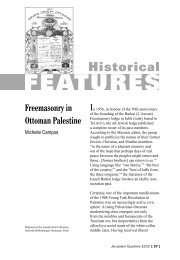
![In Search of Jerusalem Airport [pdf] - Jerusalem Quarterly](https://img.yumpu.com/49007736/1/180x260/in-search-of-jerusalem-airport-pdf-jerusalem-quarterly.jpg?quality=85)
